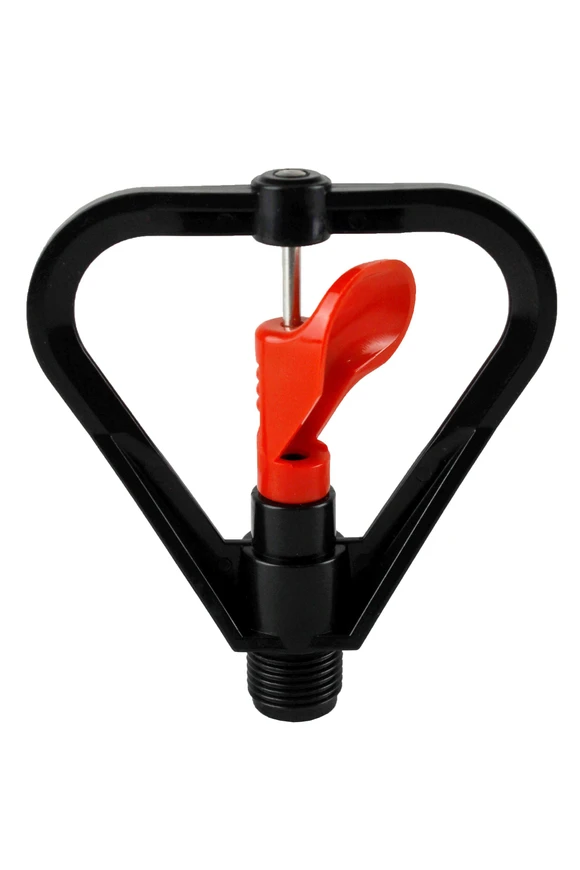Micro Sprinklers In Kenya
Micro sprinklers in Kenya by Grekkon Limited are low-pressure, low to medium volume irrigation equipment that are ideal for micro-irrigation. They deliver water directly to the crop root zone, in a uniform manner. They provide full scale surface irrigation, and localised watering of crops. Micro sprinklers are used for; fruit tree, lawn, hedge, and small garden irrigation
Micro sprinkler price in Kenya
The unit cost of all types of sprinkler jet micro sprinklers at Grekkon Limited is from Kes 100 at any of our branches nationwide. Micro sprinkler price per acre is a factor of the number of units used, which depends on the crop spacing. For instance tree tomato spaced at 2M x 2M will require a higher number of micro sprinklers than avocado spaced at 6M x 5M
Each unit is composed of 3 parts; the sprinkler, the 8mm diameter connecting tube, and a 1-1/2′ long plastic support stand
Micro sprinklers save water through high application efficiency, and uniformity of spray. They are a substitute for button drippers where drip irrigation is impractical, but create a larger wetted area than drip irrigation. Micro sprinkler irrigation provides low precipitation which allows for longer watering time with low run-off. They are available in a wide range of plastic configurations. Micro sprinkler sets are used with fertigation systems which save on fertiliser application labour cost. They are also light in weight and small in size, which makes them highly portable, and easy to install
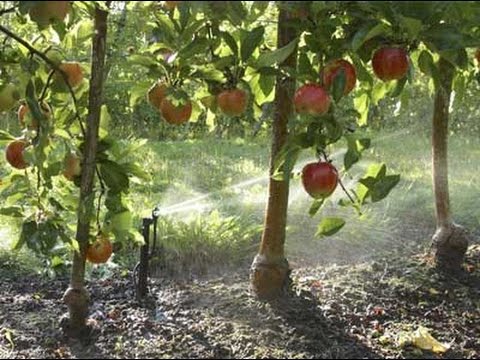
Micro sprinklers watering an apple crop
What is micro sprinkler irrigation?
It is micro irrigation through the adoption of sprinkler jet micro sprinklers, set at the base of the plant
Micro Sprinklers In Kenya
Coverage:
Micro sprinklers coverage is a factor of; flow rate, wetting diameter or radius, and the wetting degree.
1. Operating pressure; from 15M head / 1.5 bar – 20M head/ 2 bar. Pressure lower than this will cause the micro sprinkler to release large droplets, or cease rotation. These droplets will be unhelpful, or even destructive to the work undertaken
2. Flow rate 40 litres per hour
3. Irrigation degree; available as 90, 180, and 360 degrees
4. Irrigation dimeter; 1.5M to 3.5M. This is an important factor to note during installation because it guides on the spacing of one sprinkler jet micro sprinkler to another
Micro sprinklers work when positioned upright, or upside down. Upright when they’re standing on the ground for normal irrigation. Upside down when set in a greenhouse, or open field crop to provide humidity to a mature crop or seedlings. This upside down placement is also for keeping plant foliage moist, or for overhead irrigation.
They deliver irrigation water through micro tubing to a series of nozzles attached to risers. They have small to medium sized droplets with good uniformity of coverage, and lower precipitation rate.

How to space micro sprinklers
Micro sprinklers placement is in such a manner that the sprays overlap. If for instance the irrigation diameter is 1.5M, the distance between micro sprinklers will be 2.25M. This ensures that there are no dry spots in between. An overlap ensures full coverage particularly for lawns, hedges or very closely spaced crops
How to use micro sprinklers with fruit trees
Our micro sprinklers for orchards are installed this way: Set one micro sprinkler per tree, 30cm or 1 foot from the base of the tree trunk being irrigated. Unlike online or button drippers which work well with gravity, a water pump will be necessary when irrigating with many micro sprinklers. This is because they need an operating pressure of 15M – 20M head, which is best achieved by a water pump

How much water do micro sprinklers use?
They use a maximum of 40 litres per hour
Micro Sprinklers In Kenya
FAQs
1. How effective is micro sprinkler irrigation?
It reduces water usage by 25% to 40% compared to impact or rain gun sprinkler irrigation, and by 45% to 60% when compared to surface irrigation. They provide uniform water application which ensures uniform growth and crop maturity
2. How far apart should sprinkler jet micro sprinkler be?
It should be less than the radius of their spray. See details above under the heading how to space micro sprinklers
3. When do you use a micro sprinkler?
Like drip irrigation, they are great for water conservation. However, unlike drips they create a humid micro climate around the crop, which is important in the control of certain pests such as spider mites, arphids, and thrips,
4. What are the disadvantages of micro sprinkler irrigation?
4.1. The tubes get clogged more easily than those of an impact sprinkler or rain gun sprinkler. This is because they are much smaller than those of other sprinkler types
4.2. They are more expensive to install than drip lines, or button drippers
4.3. They require higher operating pressure than drip lines, or button drippers, hence the need to invest in a water pump
4.4. They require a higher level of expertise during installation than button drippers, or drip tapes
4.5. The rate of water loss due to evaporation is higher than with a button dripper, or drip irrigation system
4.6. Many units are required per unit of land compared to other larger sprinklers
5. How do micro sprinklers work?
They have micro tubings which deliver water to small openings that release it at a slow rate, as fine particles. They apply water directly to the soil surface allowing it to percolate under low pressure
6. How far do micro sprinklers spray?
1.5M to 3.5M diameter
7. What are the components of a micro-irrigation system?
7.1. A pumping station to provide the right pumping pressure
7.2. A filtration system to capture any debris or dirt that will clog the system
7.3. Mainlines. These are the pipes originating from the pumping station, and feeding the sub-main lines. They are the largest pipes
7.4. Sub-main lines. These are the pipes origination from the main lines, and feeding the laterals. They are smaller in diameter than the main lines
7.5. Laterals. These the pipes connecting to the sub-main lines, to which the micro sprinklers are attached. They are the smallest pipes in diameter
These pipes will be either be of the high density polypropylene (HDPE), or poly vinyl chloride PVC type
7.6. Hydrants. These are the irrigation control units in the field from which water is channelled to various blocks
7.7. Venturi system. This is a chemigation and/or a fertigation unit connected to the main line. It is the point from which soluble fertiliser and drenching pesticides are fed into the irrigation system
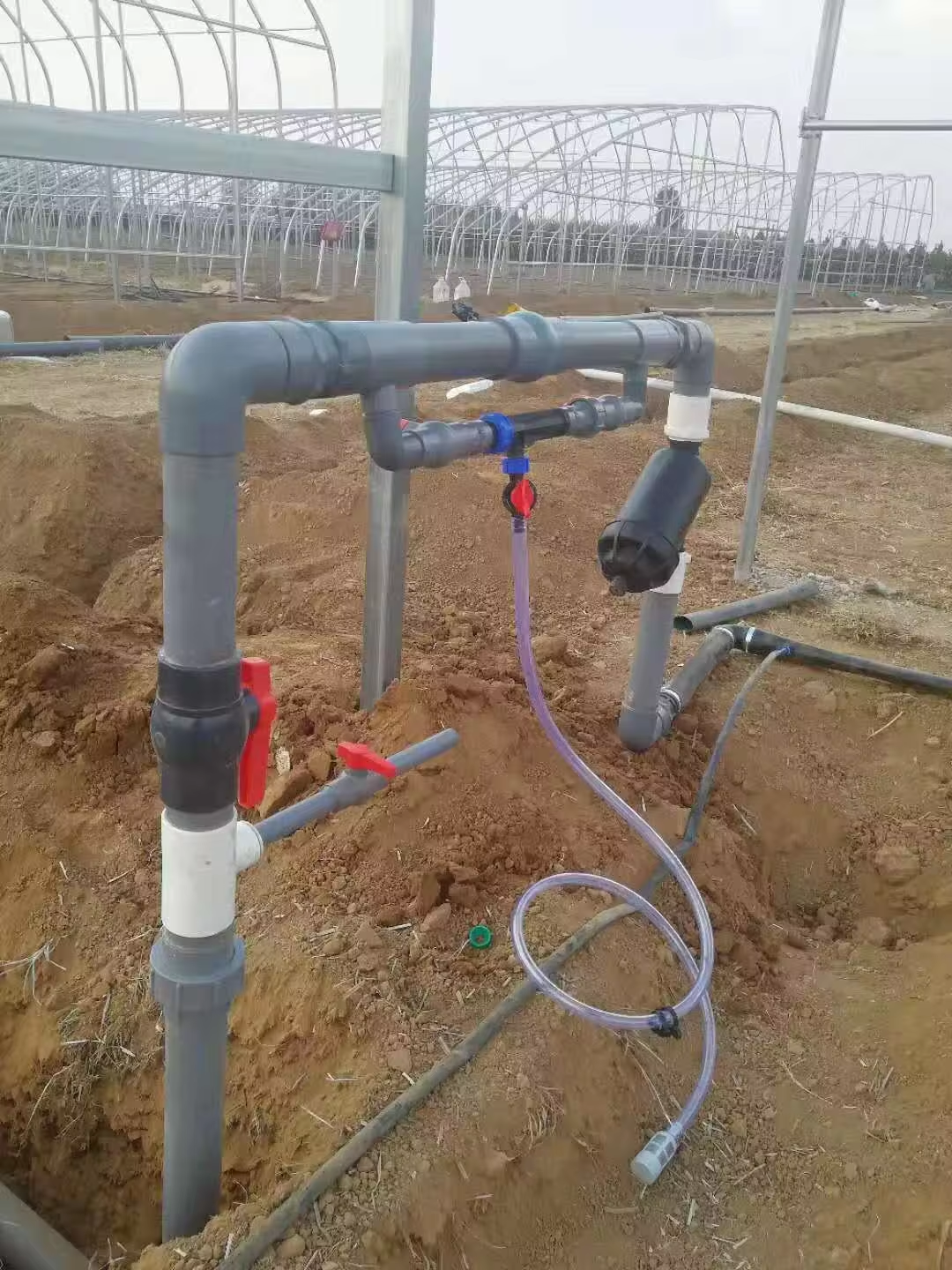
A venturi fertigation – chemigation unit being set up in an upcoming vegetable farm by Grekkon Limited
7.8. The sprinklers. They water the crops directly
8. How long to run micro sprinklers in Kenya?
35 to 45 minutes is sufficient time at optimal flow rate and working pressure
9. What is the difference between drip irrigation and micro sprinklers?
Drip irrigation is for closely spaced crops that require targeted irrigation. Micro-sprinkler irrigation is for sparsely spaced, larger crops or crops that grow best under overhead irrigation
10. What is the difference between mini and micro sprinklers in Kenya?
Mini sprinklers are larger, with a greater flow rate and operating pressure to cover a bigger area. They are better for smaller plants or landscape irrigation
Overhead Sprinklers For Irrigation
Grekkon Limited is an irrigation equipment supplier in Kenya. We design, supply, and install all types of overhead sprinklers for irrigation systems, for every acreage and crop. Our overhead sprinklers for irrigation in Kenya are of different types, for different crops, acreage and locations. This is why our technical or agronomy team will visit a grower who needs to install one. It is to assess the land layout and size, topography, water location, water volume, existing water pump if any, and the crop. Through this survey, we recommend the most appropriate sprinkler irrigation kit for the grower based on their budget. For instance, a grower with 100 acres of orchard will have a different sprinkler from a 100 acres of a park covered with grass. Similarly, a farmer on an 1/8 acres of cabbage will have a different sprinkler irrigation kit than the one with 30 acres of cabbage
Overhead Sprinklers For Irrigation
Types
We have these 5 overhead sprinklers for sale types shown below available. For most, there are both metallic and plastic versions. Metallic sprinklers have a longer lifespan, but are costlier and heavier. Plastic sprinklers are lighter, cheaper, but have a shorter period of operation. The body material does not affect the pressure rating, inlet and outlet sizes or the water discharged. For technical details on each type, click on the title links given for every sprinkler
- Rain gun sprinklers for medium-sized to large acreage. Available sprinkler sizes are; 1″, 1-1/4″, 1-1/2″, 2″, and 2.5″. We supply and install the double nozzle PY, Atom, and flange type rain guns. The latter are for broad acreage and require very high water volume, and high operating pressure
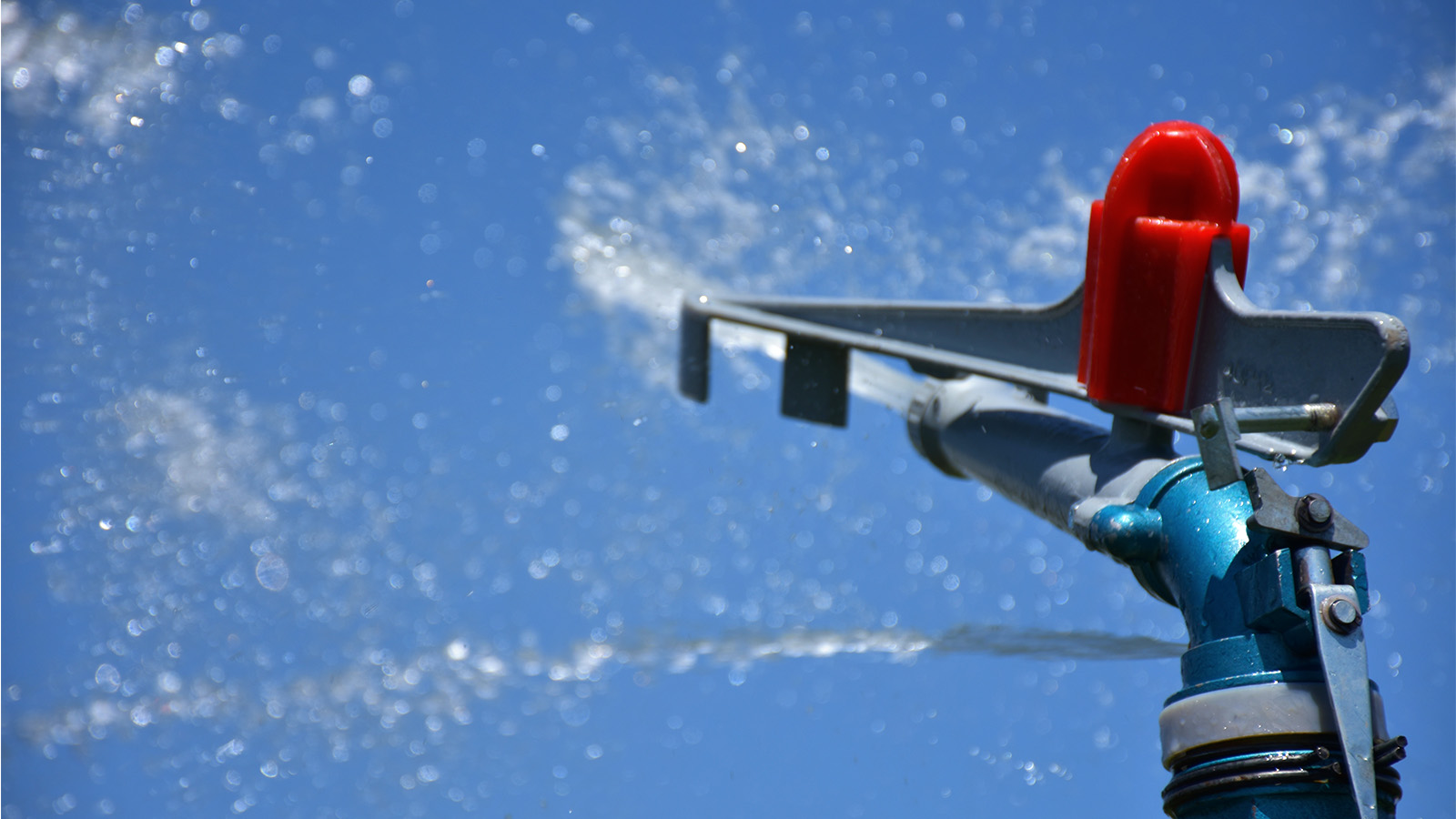
An ordinary size rain gun sprinkler at work after installation by Grekkon Limited

2.5″ giant flange type rain
A flange type rain gun video at work
2. Plastic or brass impact sprinklers for small to medium sized acreage. Our sizes are; 1/2″, 3/4″ and 1″ which have either 2-way, 3-way or 4-way nozzles
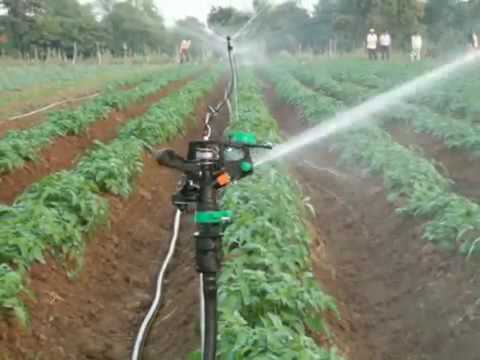
Plastic impact sprinklers
3. Mega-net sprinklers for small to medium-sized areas. We have the 1/2″, 3/4″ and 1″ which have a spray angle of 180 degrees
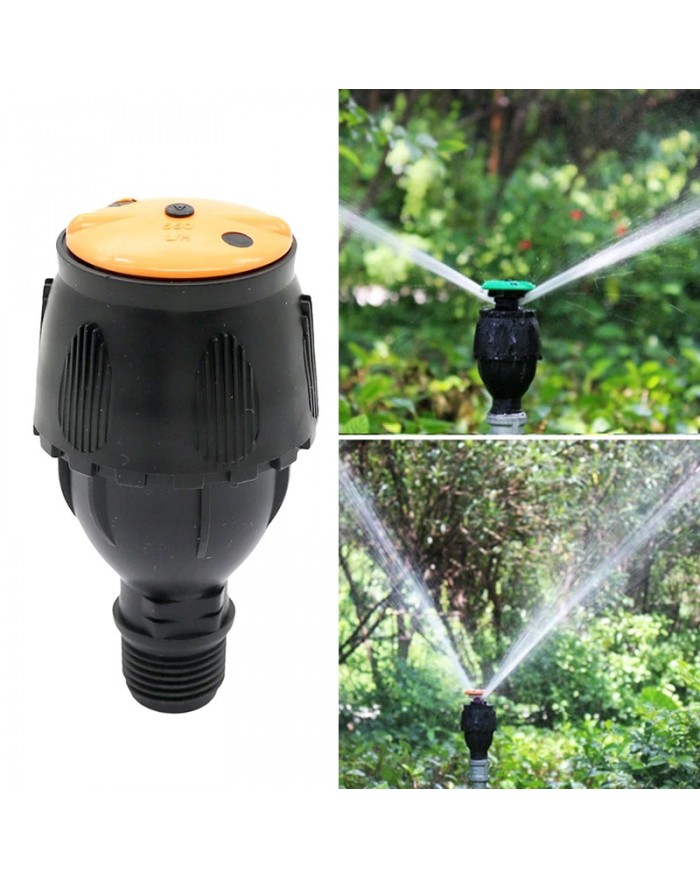
A mega net sprinkler
4. Micro sprinklers for orchards and small areas with a spray angle of 360 degrees
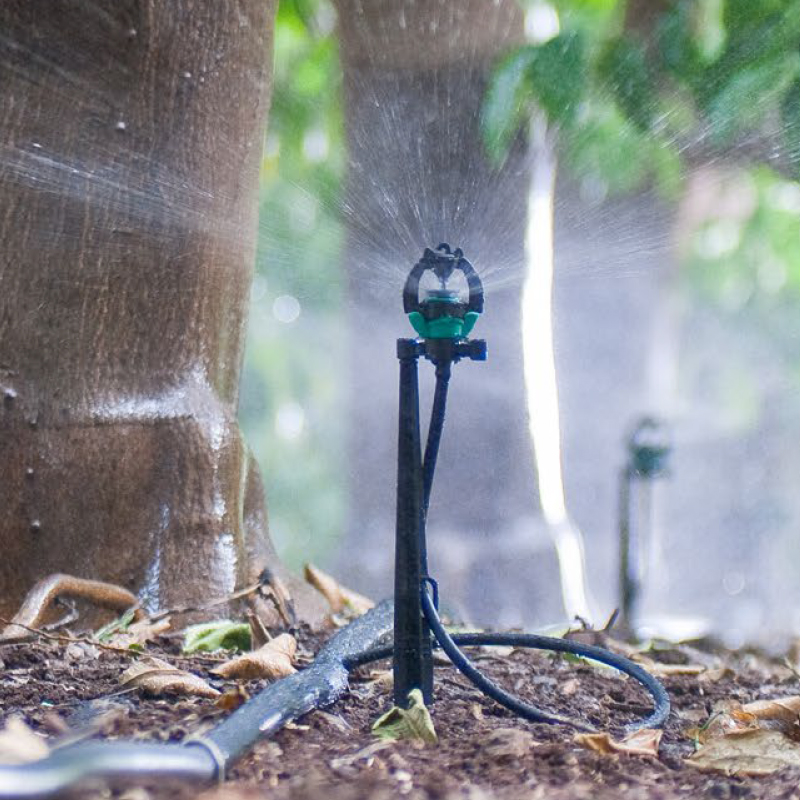
Micro sprinklers in an orchard
5. Pop up sprinklers for lawn irrigation. Our sizes are1/2″ and 3/4″ which spray up to 360 degrees

A lawn pop up sprinkler
6. Butterfly mini sprinklers for small gardens or and lawns available as 1/2″
How to choose your overhead sprinklers in Kenya
- Land size. Rain guns for large acreage, and micro-sprinklers for small plots of land
- Crop type. Pop-ups for lawn irrigation, all other sprinklers for field crops
- Ground elevation. Gravity power from high elevations will swing micro and impact sprinklers. Rain guns, Meganets, and pop-ups work with water pumps
- Grower’s budget. It determines the sprinkler type and number of units to install
Our sprinkler irrigation system design considers the above 4 factors during our site visits conducted before a sprinkler irrigation system is installed
Components of an overhead sprinkler irrigation system
- Mainline. This is PVC, HDPE, or GI to supply water from the source. It will be connected directly to the sprinkler riser pipe, or to the sub-main line
- Sub mainline. This one is connected directly to the sprinkler rise pipe, or to the sprinkler itself from the mainline. It is also PVC, HDPE, GI or a delivery/ layflat pipe
- Riser pipe. This receives water from the main line or sub-main line to the sprinkler It is also PVC, HDPE, or a GI
- Tripod or pipe stand. It is the sprinkler’s support structure
- Gate valves. They allow or block water flow to the sub mainline
Overhead sprinkler prices in Kenya per acre
- Rain gun sprinkler system from Kes 65,000
- Impact and Mega-net sprinklers from Kes 50,000
- Butterfly and Micro jet sprinklers from Kes 85,000
- Pop-up sprinklers from Kes 120,000
FAQs
A. What are the pros and cons of an overhead sprinkler irrigation?
I. Overhead sprinkler irrigation advantages
- There is a wide choice to select from
- It is easy to install
- It is cheaper than drip irrigation
- Easy to move from one point of the farm to another
II. Disadvantages
- It is water wasteful
- During strong winds, water distribution is uneven
- High running cost because a water pump is needed
- It requires labour to move it from one location to another if it’s a portable system
B. How does an overhead sprinkler irrigation system work?
- Water is pumped under high pressure from the source; tank, reservoir, lake, river to the mainline
- From the mainline, it is distributed to the sub-main lines
- From the sub-mainlines, it enters the sprinklers under pressure. This pressure swings the sprinkler in a circular motion
- The sprinkler breaks the water into fine droplets, which fall on the crop
C. How do I choose a water pump for my sprinkler system?
Consider the following when selecting a sprinkler water pump
i. Pressure rating of the sprinkler. The water pump’s pressure rating must exceed that of the sprinkler to compensate for pressure losses in the piping system. Grekkon Limited’s technical team advises growers on the best match. The larger the pipe diameter, the lower the pressure loss along the horizontal pumping distance. The longer the horizontal and vertical pumping distance, the greater the pressure loos. Pressure loss during irrigation water reticulation is also as a result of leakages along the piping system
ii. Discharge rate of the sprinkler. Like the pressure rating above, this will be higher for the water pump to cater for any fluid losses
iii. Inlet diameter of the sprinkler. That of the pump has to match this
D. Which sprinkler head is best?
Rotor sprinklers are the most efficient sprinklers in the market. They have the least run-off, and irrigate slowly, hence less wastage

